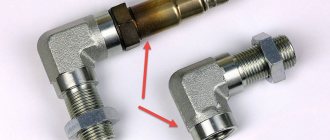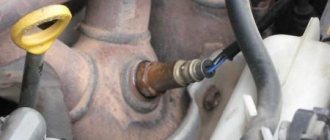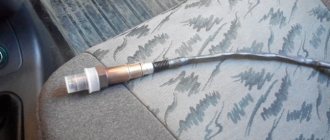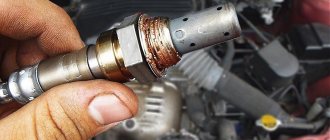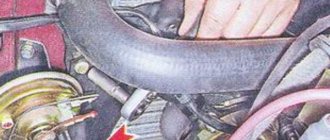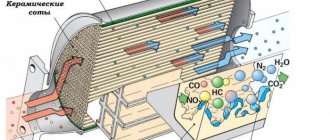Over the past centuries, human civilization has lived in clear disharmony with nature. Technological progress has not only made people's daily lives easier, but at the same time has brought about hitherto unknown problems. Pollution of the earth with various waste products of Homo sapiens reached its apogee in the 21st century, therefore modern developments by scientists in almost all areas are aimed at obtaining technologies that are as safe as possible for the environment. Considering the above, the “environmentally friendly” type of person is represented in the illustration below.
For example, internal combustion engine emissions in the latest generation of cars are less toxic due to the installation of electronic fuel injection systems. To provide feedback to monitor the efficiency of such an installation, a small sensor called a lambda probe or oxygen analyzer is mounted in the exhaust pipe.
DIY lambda probe emulator circuit
Author: Evgeny Zhivoglyadov.
Publication date: January 16, 2022. Category: Automotive equipment. Lambda probe (also called oxygen controller, O2 sensor, DC) is an integral part of the exhaust system of vehicles that meet EURO-4 environmental standards and higher. This miniature device (usually 2 or more lambda probes are installed) monitors the O2 content in vehicle exhaust mixtures, thereby significantly reducing the emission of toxic waste into the atmosphere.
If the DC is not operating correctly or if the lambda probe is disconnected, the functioning of the power unit may be disrupted, causing the engine to go into emergency mode (the Check Engine light will light up on the panel). To prevent this from happening, the car system can be outsmarted by installing a decoy.
Electronic emulator
This option is based on the use of a high-tech device based on a microprocessor circuit (MCC). Thanks to it, the operation of the power unit control systems is normalized and failures from the self-diagnosis unit are eliminated.
In reality, the ISS, which has one crystal, understands the actual situation of the exhaust gas concentration. The microprocessor receives information from the first lambda probe, after which it creates an outgoing signal on the second DC, similar to that if the catalyst was working properly.
Mechanical snag of the lambda probe (“screw-in”)
“Vvertysh” is a bushing made of bronze or heat-resistant steel. The inside of such a “spacer” and its cavities are filled with ceramic chips with a special catalytic coating. Due to this, the exhaust gases are burned faster, which, in turn, leads to different indicators of pulses 1 and 2 DC.
Important! Any snag is installed only on a working lambda probe.
A homemade lambda probe decoy, the diagram of which is presented below, is easy to manufacture. To do this you will need to prepare:
The blende is made on a processing lathe. If there is none, then you can contact a specialist by providing him with a drawing.
The resulting part is compatible with most exhaust systems of both domestic and foreign cars.
Installation of the lambda probe blende is carried out as follows:
- Lift the car onto the overpass.
- Disconnect the negative terminal on the battery.
- Unscrew the first (upper) probe (if there are two of them, then remove the one located between the catalyst and the exhaust manifold).
- Screw the lambda probe into the spacer.
- Reinstall the "advanced" sensor.
- Connect the terminal to the battery.
Healthy! Typically, mechanical blending of the second lambda probe is not performed, since this DC is protected by a catalyst and only controls its condition. The most sensitive is the first sensor, which is installed closest to the collector.
After this, the “Check Engine” system error should disappear. If this method does not work, you can use a more expensive deception.
What do spare parts manufacturers offer?
On the shelves of auto stores you can find all kinds of parts for tuning the exhaust system. The production of mechanical simulators of the normal operation of the catalytic converter is made of bronze or chrome-plated steel. The price of such devices ranges from 400 to 800 rubles, and a standard installation at a service station will cost about 500 rubles.
A spacer with a minicatalyst is offered much more expensive than its elementary counterpart, its cost is 1,500-4,000 rubles. Simple electronic emulators of industrial production are sold for 1,500-3,000 rubles. The range of prices for flashing ECU software is quite wide - from 1,000 to 30,000 rubles.
I am publishing a proven drawing of the blende for the second lambda probe.
Initially - for Lancer-9, for other cars, you may have to select the diameter of the central hole through which the second lambda “breathes”; the geometric dimensions of the lambda should also be clarified before making the spacer.
What is this for? Lancer has two catalysts and two lambda probes. The first lambda probe is used to correct the fuel mixture; it must not be touched. The second lambda probe serves to monitor the integrity of the first catalyst (it has another function - correcting the readings of the first lambda when the first lambda begins to degrade greatly, but we can completely neglect this - the main thing is that the first lambda is alive, well, it can be done in a timely manner ( when an error occurs and according to it) replace it - I have already reviewed this aspect in my BZ, you can look it up)) - if the catalyst is clogged or removed, the Check Engine light on the dashboard will light up. To prevent this from happening, the second lambda probe must be “deceived” so that the brain “thinks that everything is fine with the first catalyst, it is intact and in place.
What are the risks of driving with the catalyst removed, but the lambda probe not deceived? A glowing Check Engine light and increased fuel consumption (the brain goes into the so-called “emergency mode”).
Are there other methods? Yes. Electronic snag (resistor and capacitor, published on our Technical Maniacs Forum) and chipping - by changing literally one bit in the firmware, you can programmatically turn off polling of the second lambda probe. But the remaining two methods are associated either with the ability to hold a soldering iron in your hands, or with the ability to change the car’s firmware, or with the presence of a tuner/chip technician nearby.
Metal blende is a simple and reliable method. Its essence is that we force the lambda to breathe not “through its nose” from the pipe, but we move it a little away from the exhaust and force it to “breathe” through a small hole - which completely simulates the presence of the first functional catalyst.
The second catalyst is not controlled in any way.
If you see error P0421 (error code for Lancer, on other cars the code may be different, the code means the failure of the first catalyst) - urgently knock out both catalysts, install a blende, clear the error by removing the terminal from the battery for a few minutes - and go ahead
